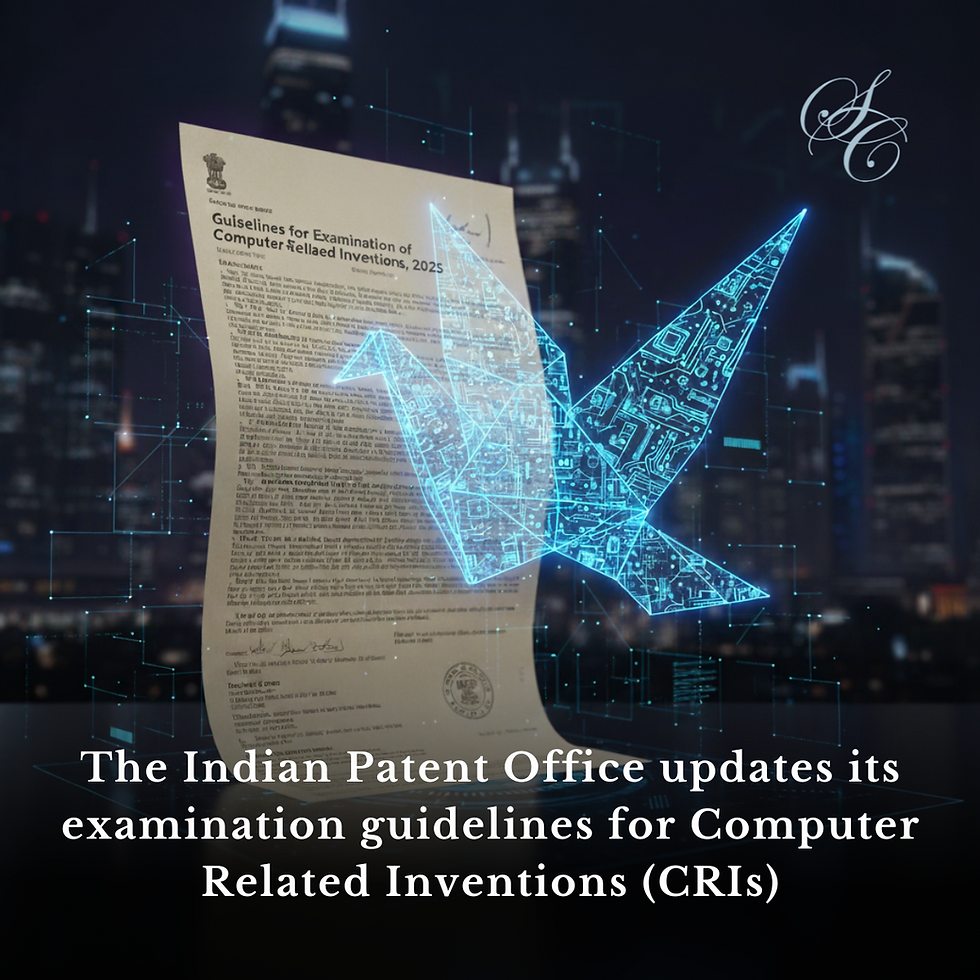The Impact of Neuroscience on How Courts in India Typically Address Trademark Disputes
- Sarwajeet Singh
- Jun 25, 2018
- 6 min read
While Indian trademark law looks at likelihood of confusion from the point of view of a consumer of average intelligence and imperfect recollection, neuroscience strips the consumer down to a quantum computer of average processing power and limited RAM. As this divergence in a court’s perception of the consumer and that of contemporary scientific literature is expected to narrow over time, this post posits the impact of neuroscience on how courts in India typically address trademark disputes.
Neuroscience has established that images, sounds and impressions are linked in a consumer’s minds through neural networks. The very purpose of deploying neuroscience research in formulating brand strategy is to trigger associations in a consumer’s mind between images, sounds and impressions and the source of the product/service. The quicker the association is triggered, the stronger the brand. But, brands do not exist in vacuum, they compete with others for the fastest possible association. Thus, the odds of competing brands triggering multiple associations in a consumer’s mind when exposed to the same word, sound or sensory impression are not entirely implausible – even in the absence of deceptive intent. This begets the question – to what extent does Indian trademark law grant a brand owner exclusivity to encode the fastest possible association in a consumer’s mind?
Notably, besides recognizing the likelihood of confusion as a test for infringement, the Indian trademark statute also recognizes the likelihood of association. While consumer confusion conjures imagery of a consumer mistaking one brand for another while purchasing an item or viewing an advertisement, consumer association, though subtler, is also recognized by neuroscience as a harm to brand identity. India, being a common law country, gives judges an active role in developing rules. Thus, although the trademarks statute lists out different situations where a trademark is infringed, the nuances of whether infringement has occurred or not, are provided for in case law and not in statute.
In August 2006, the Indian Supreme Court “took note” of the excerpts of the European Court of Justice’s decision in Canon Kabushiki Kaisha v. Metro-Goldwyn-Mayer Inc., (1999) RPC 117 (See: Ramdev Food Products v. Arvindbhai Rambhai Patel, Order dt. 29.08.2006 in Civil Appeal Nos. 8815-8816 and 8817 of 2003), where two kinds of consumer association were identified. First, indirect confusion – where the consumer makes a connection between the owners of the rival marks, and is, consequently, confused as to the source of the product/service. Second, association in the “strict sense” – where, although, the consumer makes a connection between the rival marks, he is, ultimately, able to discern the marks and their source. As far as association in the form of indirect confusion is concerned, trademark law’s recognition of the harm provokes little debate. However, as far as association in a “strict sense” is concerned, neuroscientist and psychologists, alike, are yet to find common ground.
The proponents of recognizing association in a “strict sense” as a legally redressable harm argue that the greater number of associations that a consumer makes when exposed to a mark, the lesser is its distinctiveness. Thus, the argument concludes, famous trademarks would ultimately sink into the pits of genericity if this kind of dilution is unchecked. On the other hand, the opposing literature argues that famous marks that are not used as frequently in contemporary parlance are, in fact, helped by a multiplicity of consumer associations. Here, I recall a press statement by Mahesh Manjrekar, a Marathi film director, who was the defendant in one of the lawsuits the firm filed i.e. Rubik’s Brand Ltd. v. Mahesh Manjrekar. In April 2016, the Bombay High Court restrained Mr. Manjrekar from releasing a movie with the title RUBIK’S CUBE. After the court’s decision, Mr. Manjrekar went to press stating he thought “the title would help to promote the game further.” It seems, unlikely though, that Indian trademark law would recognize such benevolent associations as a defence to an infringement claim by owners of famous marks.
Besides a comparison of the goods/ services and the marks, Indian trademark law also begets a scrutiny of the rival trade channels and consumers in assessing the merits of an infringement claim. Here, neuroscience would also consider relevant – the party whose consumer would be the focus of the analysis. On this basis, neuroscience differentiates blurring and tarnishment from simple piggyback riding – while simple free riding focuses on the behaviour of the newcomer’s customers, blurring/ tarnishment focus on that of the senior user.
Piggyback Riding
If, for example, a chain of pizza outlets that does business under the brand THOR, exclusively in the United States, were to take issue with an Indian shoe manufacturer using the same mark in India – it is plausible, as per neuroscience, that although Indian consumers do not frequent the pizza outlets, they would, nevertheless, associate the shoe manufacturer to the pizza restaurant – even if they are well-aware of the source.
Although there is no direct confusion in this case, as the pizza chain expands its links across the world, the shoe manufacturer would, in a way, free ride on its reputation in India. Moreover, since India ascribes to the principle that trademark rights are considered separate in each sovereign jurisdiction, a situation may develop where Indian consumers recognize that although THOR is associated with pizza chain on a worldwide basis, in India, THOR is a footwear brand. Though neuroscience recognizes this as a long-term harm to brand identity, Indian law would check it only if the pizza chain is able to prove that its worldwide reputation has spilled over into India – which is not a given since margherita pizzas cannot simply be shipped to Indian consumers from outlets abroad. While Indian trademark law would refuse to interfere at this juncture, neuroscience would, nevertheless, cause the pizza chain marketing team to rue to multiplicity of associations triggered by THOR in the minds of Indian consumers.
Blurring & Tarnishment
While Indian law recognises blurring as initial interest confusion, neuroscience perceives it as the delay in associating the mark to source resulting from consumers conjuring multiple associations of source in respect of the same mark. Neuroscience considers the brain a quantum computer and describes the effect of initial interest confusion as a “slowdown in processing time”. Once again, Indian law addresses blurring only to the extent the senior user of a mark is able to establish a strong reputation in the mark that justifies its protection.
However, as far as tarnishment is concerned, Indian trademark law did, until lately, appear to address the harm without qualifying the scope thereof identified by neuroscience. In July 2016, the Bombay High Court defined tarnishment as a detrimental reference to a mark (See: Raymond v. Raymond Pharmaceutical, Order dt. 20.07.2016 in Suit (L) No. 957 of 2014), not far off from its recognition in neuroscience as a multiplicity of associations involving, not just the rival marks, but also negative connotations and/ or emotions.
In December 2011, the Delhi High Court restrained a manufacturer of tobacco products from using the plaintiff’s RASNA mark (which was used in respect of soft drink concentrates since 1972) on grounds of tarnishment (See: Piruz Khambatta v. Soex India, Order dt. 23.12.2011 in C.S. (OS) No. 2397 of 2011). Since tobacco products in India, must necessarily be sold with graphic labels that remind consumers that the product is injurious to health and causes cancer, the court ruled that brand tarnishment would likely occur if the defendant was not restrained.
Although Indian courts have traditionally addressed tarnishment while analysing the motive behind a defendant’s adoption of the disputed mark, this approach, which had served right holders well so far, suffered a setback in the Supreme Court’s December 2017 decision in Toyota Jidosha Kabushiki Kaisha v. Prius Auto Industries Ltd. (Order dt. 14.12.2017 in Civil Appeal Nos. 5375-5377 of 2017). In Toyota, the plaintiff, who was the earlier adopter of the coined mark PRIUS on and in relation to automobiles, sought to restrain the defendant’s use of the same mark on and in relation to automobile accessories. Although, the Supreme court refused to restrain the defendant because the plaintiff failed to show that its worldwide reputation in PRIUS had spilled over into India, the Supreme court’s decision was, remarkably, silent on the defendant’s motive behind adopting the identical mark PRIUS. This is atypical of the approach traditionally followed by Indian courts, including that of the Supreme court – where the defendant’s adoption of an identical mark is treated with strong suspicion, particularly if the plaintiff’s mark is an inherently distinctive coined term.
***
While neuroscience-driven brand strategy strives to minimise the number of associations a consumer would make when exposed to a trademark, courts in India would only protect brands from multiplicity of associations in respect of the same kind of goods/services – unless the plaintiff proves that it has spent money and acquired a significant reputation in the mark, or if the defendants’ adoption of the mark is shown to be dishonest. While the big established brand would continue to benefit from this approach, it is the start-up that would find it difficult to use litigation in India to supplement a neuroscience-driven brand strategy – particularly in the modern reality of the average consumer cursed with a declining attention span.




Comments